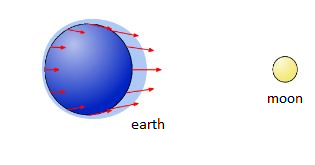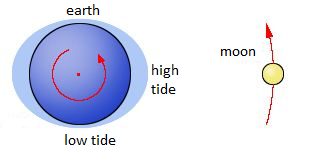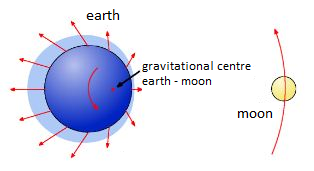tides
Move the slider speed slightly to the right to start the rotation of the moon around the earth.
You can see that twice a day it's high tide.
You've certainly the reason for this in the lessons of geography.
The cause of the tides is the gravitational force of the moon.

The nearest and the farthest points to the moon get high tide. Perpendicular to this places there's low tide.
Since the earth is rotatig around its axis in 24 hours, you get twice a day high tide and low tide in each place on earth.

Now the advanced level: Why is there high tide in the farthest point to?
As the Earth spins on its own axis, ocean water is kept at equal levels around the planet by the Earth's gravity pulling inward and centrifugal force pushing outward. However, the Moon's gravitational forces are strong enough to disrupt this balance by accelerating the water towards the Moon. This causes the water to 'bulge.' As the Moon orbits our planet and as the Earth rotates, the bulge also moves. The areas of the Earth where the bulging occurs experience high tide, and the other areas are subject to a low tide.
Water on the opposite side of Earth facing away from the Moon also bulges outward (high tide), but for a different and interesting reason: in reality, the Moon and the Earth revolve together around a common gravitational center between them, or center of mass. Here's a rough but helpful analogy: picture yourself swinging a heavy object attached to a rope around your body as you rotate. You have to lean back to compensate, which puts the center of mass between you and the object. With the Earth-Moon system, gravity is like a rope that pulls or keeps the two bodies together, and centrifugal force is what keeps them apart. Because the centrifugal force is greater than the Moon's gravitational pull, ocean water on the opposite side of the Earth bulges outward.

effect on the moon's orbit
The relative geravitational forces between earth and moon affected the moon's orbit in time. You can read more on it at secular acceleration of the moon.